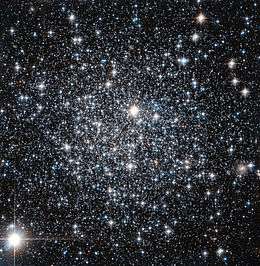IC 4499
| IC 4499 | |
|---|---|
 | |
| Observation data (J2000 epoch) | |
| Class | XI[1] |
| Constellation | Apus |
| Right ascension | 15h 00m 18.57s[2] |
| Declination | −82° 12′ 49.6″[2] |
| Distance | 50,000 ly (15,000 pc)[1] |
| Apparent magnitude (V) | 9.76[3] |
| Apparent dimensions (V) | 7.6′ × 7.6′[1] |
| Physical characteristics | |
| Metallicity | = -1.53[3] dex |
| Other designations | GCl 30[2] |
IC 4499 is a loose globular cluster in the constellation Apus. It is located in the medium-far galactic halo.[4] Its apparent magnitude is 9.76,[1] and was thought to unusual because it appears to be 3-4 billion years younger than most other globular clusters in the Milky Way, as determined by metallicity measurements in 1995.[4] However, this was contradicted in 2011 by results that yielded a much older age of 12 billion years.[5]
References
- 1 2 3 4 Frommert, Hartmut. "IC 4499". Students for the Exploration and Development of Space. Retrieved 22 April 2012.
- 1 2 3 "IC 4499". SIMBAD. Centre de données astronomiques de Strasbourg. Retrieved 20 February 2017.
- 1 2 William E. Harris. "Catalog of Parameters for Milky Way Globular Clusters". Retrieved 3 February 2017.
- 1 2 Ferraro, I.; Ferraro, F.R.; Pecci, F. Fusi; Corsi, C.E.; Buonanno, R. (August 1995). "Young globular clusters in the Milky Way: IC 4499". Monthly Notices of the Royal Astronomical Society. SAO/NASA ADS Astronomy Abstract Service. 275 (4): 1057–1076. Bibcode:1995MNRAS.275.1057F. doi:10.1093/mnras/275.4.1057.
- ↑ Walker, A. R.; et al. (July 2011), "Constraints on the formation of the globular cluster IC 4499 from multiwavelength photometry", Monthly Notices of the Royal Astronomical Society, 415 (1): 643–654, arXiv:1103.4144, Bibcode:2011MNRAS.415..643W, doi:10.1111/j.1365-2966.2011.18736.x.
This article is issued from
Wikipedia.
The text is licensed under Creative Commons - Attribution - Sharealike.
Additional terms may apply for the media files.